More than ever, Apple is only giving the iPhone 14 Pro (Max) the latest innovations. With the Dynamic Island, the manufacturer combines elegant animations with clever functions to create a coherent interface that makes a virtue out of necessity. However, the smartphone is also the class leader in other areas.
Table of contents
- 1 Ready for the island
- Inflation and weak euro cause prices to rise
- Technical data at a glance
- iPhone 14 Pro Max is thicker and heavier
- Stainless steel frame keeps SIM compartment
< li>Dynamic Island replaces Notch
- A new form of multitasking
- The best OLED display for a smartphone
- APL now also decisive for brightness at Apple< /li>
- More than 2,300 cd/m² is a new record
- Always-on-Display works with 1 Hz
- Energy consumption reduced through energy saving measures
- Everest and Sawtooth as new CPU cores
- Larger L2 cache, smaller SLC
- Apple GPU stays at five cores
- The highest single-core and multi-core performance
- Apple has the highest gaming performance
- Consistently high Performance under constant load
- Runtimes almost at previous level
- Video streaming for over 22 hours
- Charging with up to 20 watts
- 12 MP is still standard
- Photonic Engine implements Deep Fusion earlier
- Not everything has gotten better
- Apple, Google and Samsung in image comparison
- Photos at night
- ProRAW with 48 MP in comparison
- Crop as a new double magnification
- Maximum zoom remains Samsung's strength
- Action mode for stable video recordings
- Better stabilization with certain disadvantages
- Normal video mode remains top of the class
- Cinema mode expanded by 4K and 24 FPS
- New acceleration sensor up to 256 G
- SOS via satellite only for USA and Canada
- Conclusion
The iPhone goes into the next round with model number 14 and this time it is only offered in two sizes: large and even larger. There is no “iPhone 14 mini” this time, instead Apple is offering the iPhone 14 and iPhone 14 Pro in 6.1 inches and 6.7 inches respectively. The iPhone 14 Plus is new in the portfolio, but in contrast to the other three models already available, it is not due to be launched until October 7th. This test focuses on the iPhone 14 Pro Max, while a test specifically for the iPhone 14 is planned for the coming week.
Inflation and the weak euro cause prices to rise
Apple's new smartphones have become more expensive across the board. Global inflation and the bad euro against the US dollar mean that the iPhone 14 Pro with 128 GB only starts at 1,299 euros – 150 euros more than last year. The basic model of the iPhone 14 Pro Max costs at least 1,449 euros and is therefore 150 euros more than the iPhone 13 Pro Max (test). The price difference can be even higher, for example with the variant with 512 GB, which costs 190 euros more this year. For the tested iPhone 14 Pro Max with 1 TB, the price increase of 270 euros even leads to a final price of 2,099 euros.
iPhone 14 Pro and iPhone 14 Pro Max have been available since April 9 . September available in Germany in the colors dark purple, gold, silver and space black (test device).
Overview of technical data
Apple iPhone 14 Apple iPhone 11Apple iPhone 11 ProApple iPhone 11 Pro MaxApple iPhone 12Apple iPhone 12 miniApple iPhone 12 Pro MaxApple iPhone 12 ProApple iPhone 13Apple iPhone 13 miniApple iPhone 13 ProApple iPhone 13 Pro MaxApple iPhone 14 ✔Apple iPhone 14 Plus ✔Apple iPhone 14 Pro ✔ Apple iPhone 14 Pro Max ✔Apple iPhone XApple iPhone XrApple iPhone XsApple iPhone Xs Max Apple iPhone 14 Plus Apple iPhone 11Apple iPhone 11 ProApple iPhone 11 Pro MaxApple iPhone 12Apple iPhone 12 miniApple iPhone 12 Pro MaxApple iPhone 12 ProApple iPhone 13Apple iPhone 13 miniApple iPhone 13 ProApple iPhone 13 Pro MaxApple iPhone 14 ✔Apple iPhone 14 Plus ✔Apple iPhone 14 Pro ✔Apple iPhone 14 Pro Max ✔Apple iPhone XApple iPhone XrApple iPhone XsApple iPhone Xs Max Apple iPhone 14 Pro Apple iPhone 11Apple iPhone 11 ProApple iPhone 11 Pro MaxApple iPhone 12Apple iPhone 12 miniApple iPhone 12 Pro MaxApple iPhone 12 ProApple iPhone 13Apple iPhone 13 miniApple iPhone 13 ProApple iPhone 13 Pro MaxApple iPhone 14 ✔Apple iPhone 14 Plus ✔Apple iPhone 14 Pro ✔Apple iPhone 14 Pro Max ✔Apple iPhone XApple iPhone XrApple iPhone XsApple iPhone Xs Max Apple iPhone 14 Pro Max Apple iPhone 11Apple iPhone 11 ProApple iPhone 11 Pro MaxApple iPhone 12Apple iPhone 12 miniApple iPhone 12 Pro MaxApple iPhone 12 ProApple iPhone 13Apple iPhone 13 miniApple iPhone 13 ProApple iPhone 13 Pro MaxApple iPhone 14 ✔Apple iPhone 14 Plus ✔Apple iPhone 14 Pro ✔Apple iPhone 14 Pro Max ✔Apple iPhone XApple iPhone XrApple iPhone XsApple iPhone Xs Max Software:
(at release) iOS 16 Display: 6.10″, 1170 × 2532
457 ppi, 60 Hz
OLED, HDR, Ceramic Shield 6.70″, 1284 × 2778
457 ppi, 60 Hz< br>OLED HDR Ceramic Shield 6.10″, 1179 × 2556
461 ppi, 120 Hz
OLED HDR Ceramic Shield 6.70″, 1290 × 2796
460 ppi, 120 Hz< br>OLED, HDR, Ceramic Shield Operation: touch, face scanner SoC: Apple A15 Bionic
2 × Avalanche, 3.20 GHz
4 × Blizzard, 2.00 GHz
5 nm, 64-bit Apple A16 Bionic
2 × Everest, 3.46GHz
4 × Sawtooth, 2.00 GHz
4 nm, 64-bit GPU: Apple Penta-Core RAM: 6,144 MB
LPDDR4X 6,144 MB
LPDDR5 Storage: 128/256/512 GB 128/256/512/1,024 GB 1st Camera: 12.0 MP, 2160p
Quad LED, f/1.5, AF, OIS 48.0 MP, 2160p
Nona LED, f/1.8, AF, OIS 2nd Camera: 12.0 MP, f/2.4 12.0 MP, f/2.2, AF 3rd Camera: No 12.0 MP, f/2.8, AF, OIS 4th Camera: No 5th Camera: No 1st Front Camera: 12.0 MP 2160p
Display Flash, f/1.9, AF 2nd Front Camera: No GSM: GPRS + EDGE UMTS: DC-HSPA
↓42.2 ↑5.76 Mbit/s LTE: Advanced Pro 5G: NSA/SA WLAN: 802.11 a/b/g/n/ac/ax Bluetooth: 5.3 Location: A-GPS, GLONASS, BeiDou, Galileo, QZSS Other standards: Lightning, UWB, NFC SIM card: nano SIM, dual SIM battery: 3,279 mAh (12.68 Wh), 20.0 W
permanently installed, wireless charging 4,325 mAh (16.68 Wh) , 20.0 W
permanently installed, wireless charging 3,200 mAh (12.38 Wh), 20.0 W
permanently installed, wireless charging 4,323 mAh (16.68 Wh), 20.0 W
Permanently installed, wireless charging Size (W×H×D): 71.5 × 146.7 × 7.80 mm 78.1 × 160.8 × 7.80 mm 71.5 × 147.5 × 7.85 mm 77.6 × 160.7 × 7.85 mm Degree of protection: IP68 Weight: 172 g 203 g 206 g 240 g Price: 999 €/1,129 €/1,389 € 1,149 €/1,279 €/1,539 € 1,299 €/1,429 €/1,689 €/€1,949 €1,449/€1,579/€1,839/from €2,099
iPhone 14 Pro Max is thicker and heavier
The basic form factor has not changed with the new generation, so that an iPhone 14 Pro is not recognizable as such at first glance, with the exception of the updated colors. Only equipped with a vernier caliper would you find that the new devices are 7.85 instead of 7.65 mm thick and a few tenths of a millimeter shorter (Pro Max) or longer (Pro). The tested iPhone 14 Pro Max is also slightly heavier than last year's model at 240 g. Laypersons will most likely recognize the new from the old model by the even larger cameras, whose bezels occupy more depth and thus form an even more dominant feature on the back. Old iPhone 13 Pro cases do not fit around the iPhone 14 Pro.
Stainless steel frame keeps SIM compartment
Design features like the glossy stainless steel frame and frosted Ceramic Shield glass also remain unchanged, while the regular iPhone 14 is designed the exact opposite in terms of glossy and matte finishes. On the iPhone 14 Pro Max, European buyers will still find a nano-SIM slot that can be expanded with an eSIM, while US customers can only use the eSIM. Dual SIM can also be implemented with two eSIMs if desired. Above all outside of Europe, eSIM is an extremely practical feature, regardless of the smartphone manufacturer, for loading the data card of an MVNO onto the device and thus avoiding expensive data packages from the domestic provider.
-
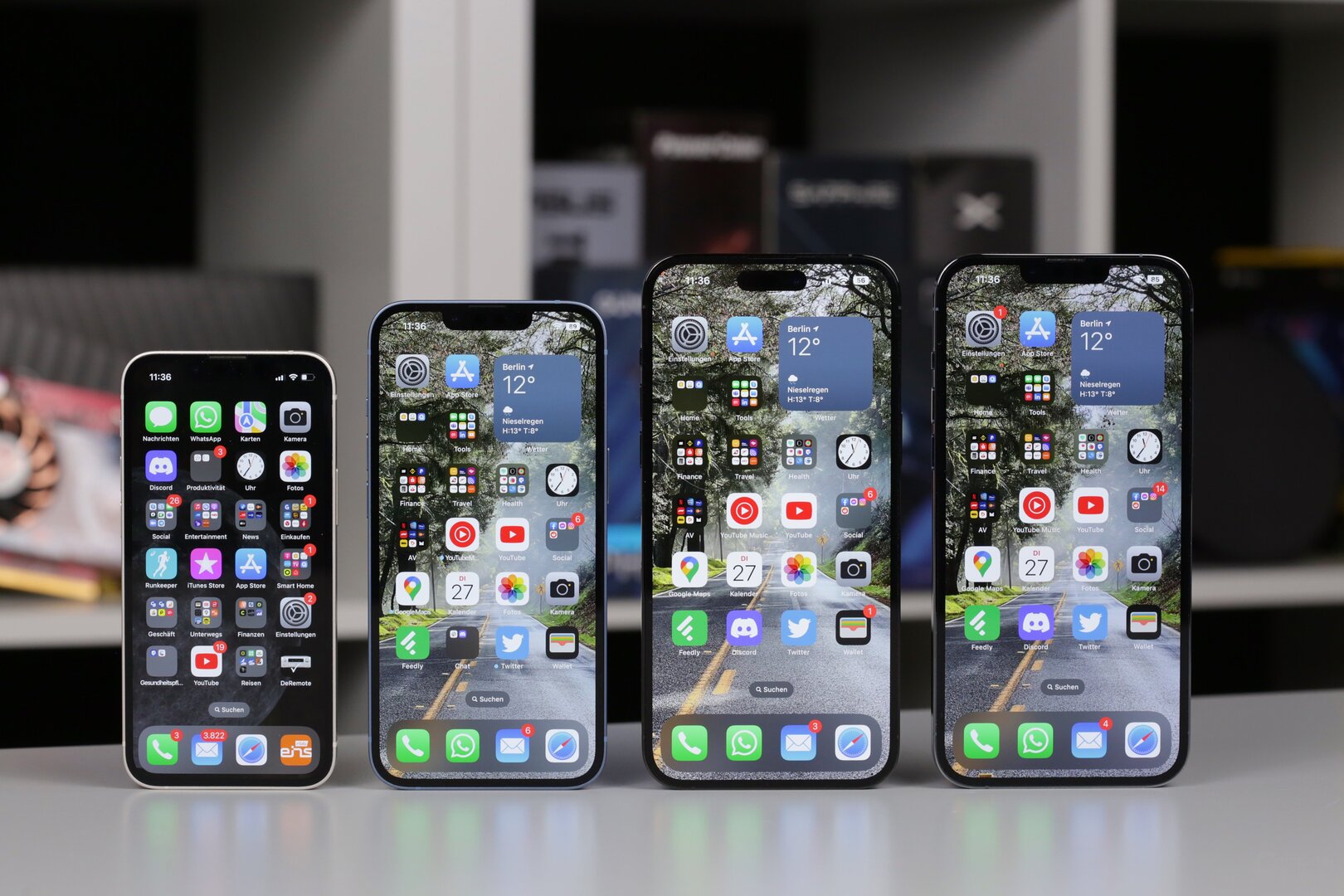 iPhone 13 mini, iPhone 14, iPhone 14 Pro Max, iPhone 13 Pro Max
iPhone 13 mini, iPhone 14, iPhone 14 Pro Max, iPhone 13 Pro Max
Image 1 of 4
 In Europe, the iPhone 14 Pro Max retains the Nano SIM slot
In Europe, the iPhone 14 Pro Max retains the Nano SIM slot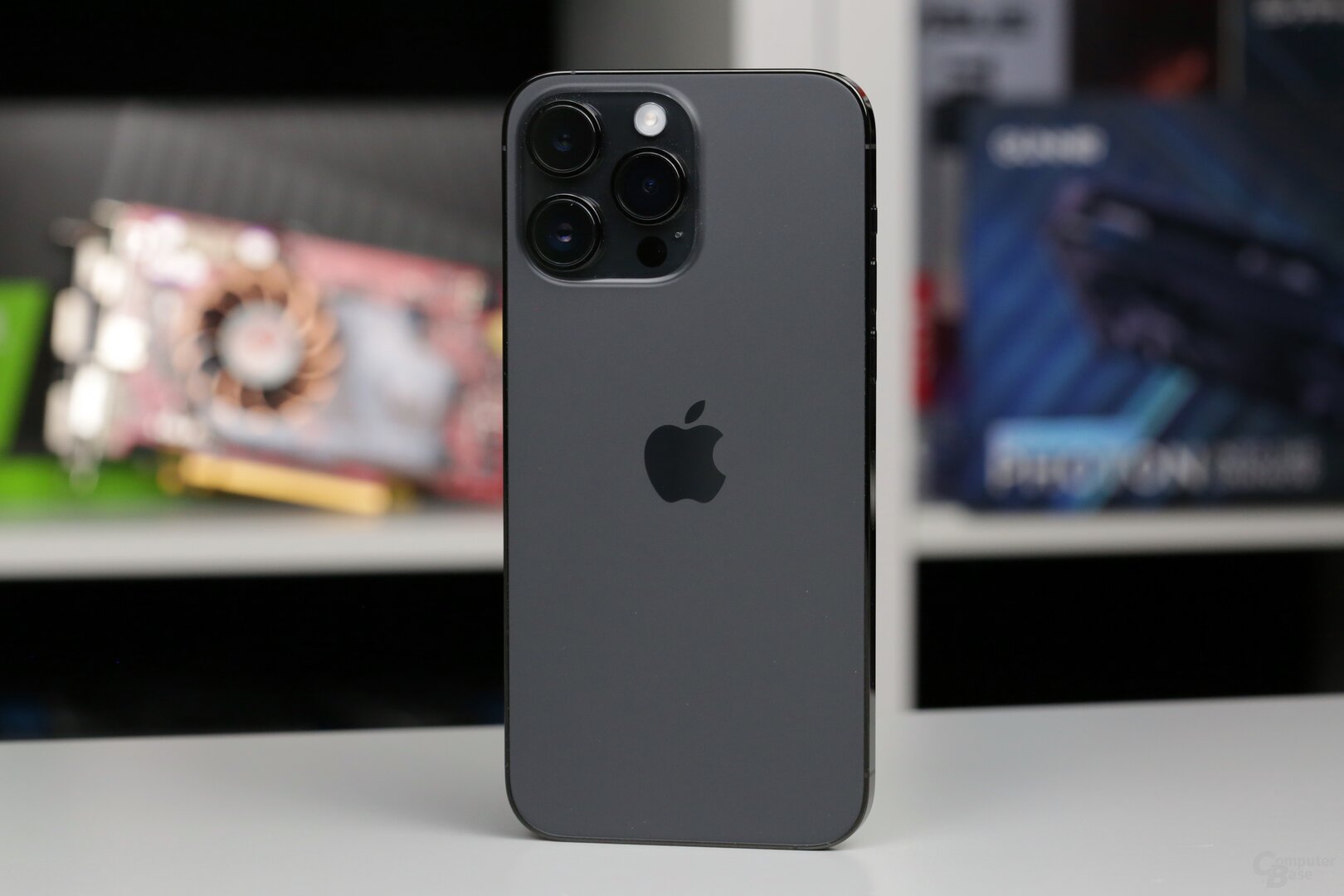 iPhone 14 Pro Max with matte glass back
iPhone 14 Pro Max with matte glass back iPhone 14 Pro Max in Space Black next to iPhone 13 Pro Max in Sierra Blue
iPhone 14 Pro Max in Space Black next to iPhone 13 Pro Max in Sierra BlueExcellent processing
Apple rewards the significantly higher prices with excellent workmanship, which is nothing to complain about. Even small details like the haptic feedback of the keys are excellent. Apple is one of the few manufacturers, along with OnePlus, that continues to offer a physical toggle for switching to silent mode. The iPhone 14 Pro (Max) also comes again with IP68 certification and is therefore protected from dust and submersion in water up to 6 m deep for up to 30 minutes.
Dynamic Island replaces Notch
One of the big changes of the current year is only found by buyers when they switch on the display, which now has the area called “Dynamic Island” by Apple instead of the “Notch” in the upper area, in which the sensors for Face ID and the front camera are housed now offers an autofocus. After the notch, which was already reduced last year, this is Apple's second change on the way to a format-filling display that houses all the sensors behind the panel. However, before this development step can be taken, users will have to get used to a more or less large gap in the screen.
-
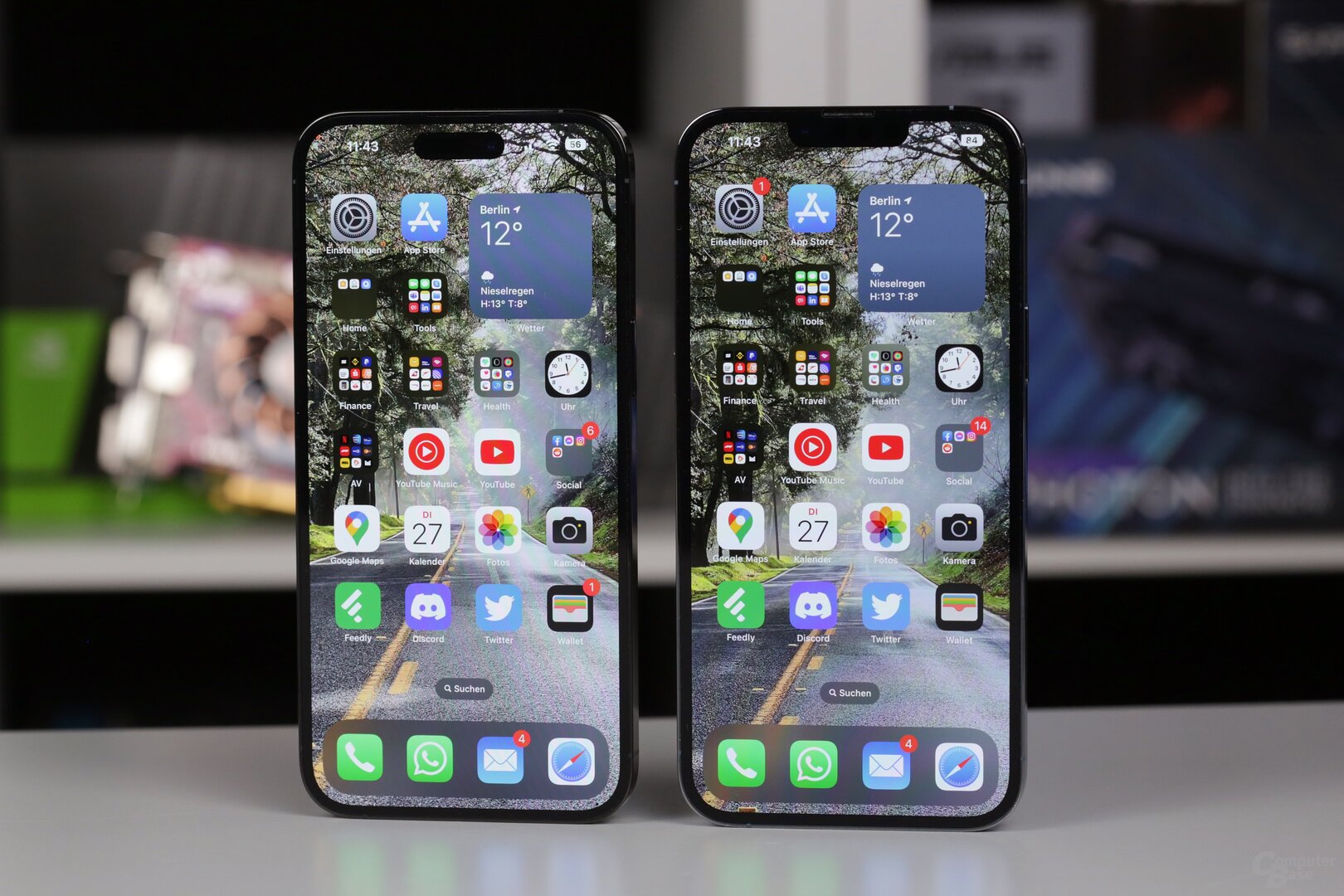 iPhone 14 Pro Max with Dynamic Island and iPhone 13 Pro Max with Notch compared
iPhone 14 Pro Max with Dynamic Island and iPhone 13 Pro Max with Notch compared
Image 1 of 2
 In very bright light, the components are visible
In very bright light, the components are visibleOne pill instead of two recesses
With the iPhone 14 Pro (Max), Apple turns necessity into a virtue and creates a new interactive area from the necessary gap, the content and functions of which adapt dynamically. The “island” in the OLED panel is just that most of the time: a contiguous island. Although the Face ID sensors and the front camera have separate cutouts in the screen, the components are not displayed individually, but rather rendered as a large “pill” using black pixels. Because black pixels can actually be displayed as such on an OLED panel, the transition is not particularly noticeable. However, if bright light hits the front of the smartphone at an unfavorable angle, the individual elements can still be made out.
Compared to the previous peninsula aka Notch, the real island on the screen is 31 percent smaller, but is now a few millimeters further into the displayed content. Apple has chosen the position so cleverly that a video in 16:9 format can be played without touching the island, which means that it disappears into the black bars. Only when films and series are stretched across the full width of the panel does the island advance into the visible area and can be visually perceived. In exchange for the deeper position in the screen, there are a few extra rows of pixels above the area, which thus floats freely in the display. Similar to the classic notch, however, this aspect quickly recedes into the background so that no visually disturbing feature is perceived.
 Full screen video showing the Dynamic Island in the content
Full screen video showing the Dynamic Island in the contentClever placed symbols and animations
The “dynamic” in the name results from the use of the area for interaction with certain status messages and the dynamic change of view. By default, the Dynamic Island is just a big black pill, but a lock for the locked state is already displayed on the lock screen as additional information on the far left next to the Face ID sensor. Apple always places the symbols in such a way that they are displayed next to or between the components. Arriving on the home screen, the pill shrinks into a smaller format with a chic animation including advanced antialiasing and only occupies the area that is absolutely necessary based on the sensors.
A new form of multitasking
In everyday life, the Dynamic Island is particularly noticeable with apps such as music, timers or calls. If music is played and minimized, which works not only with Apple Music, but also with YouTube Music, for example, the island shows a compact cover art and a wave pattern of the music in the same color as the cover. If a timer is running on the smartphone, it also ticks in the island and can therefore be viewed in a second position next to the notifications view. It gets interesting when several pieces of status information are combined, for example when music and a timer are running in parallel in the background. Then the Dynamic Island is divided into two areas and provides separate buttons for both apps. In this mode, two islands are also displayed on the screen.
- < figure class="gallery__figure">
 Music widget on long hold Dynamic Island
Music widget on long hold Dynamic Island
Image 1 of 5
 Widget for the timer
Widget for the timer Larger Dynamic Island when the timer is active
Larger Dynamic Island when the timer is active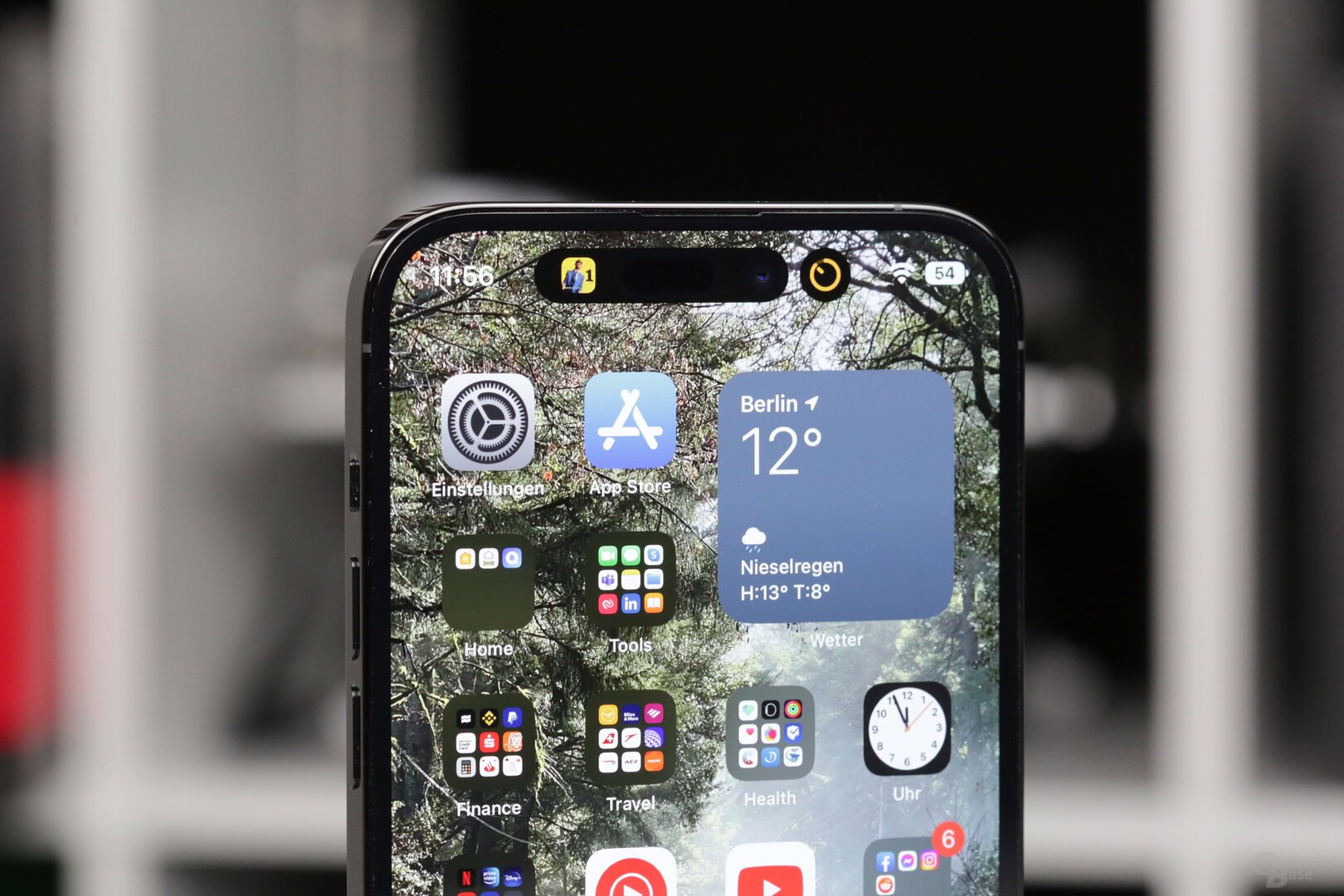 Split Dynamic Island for music and timer
Split Dynamic Island for music and timer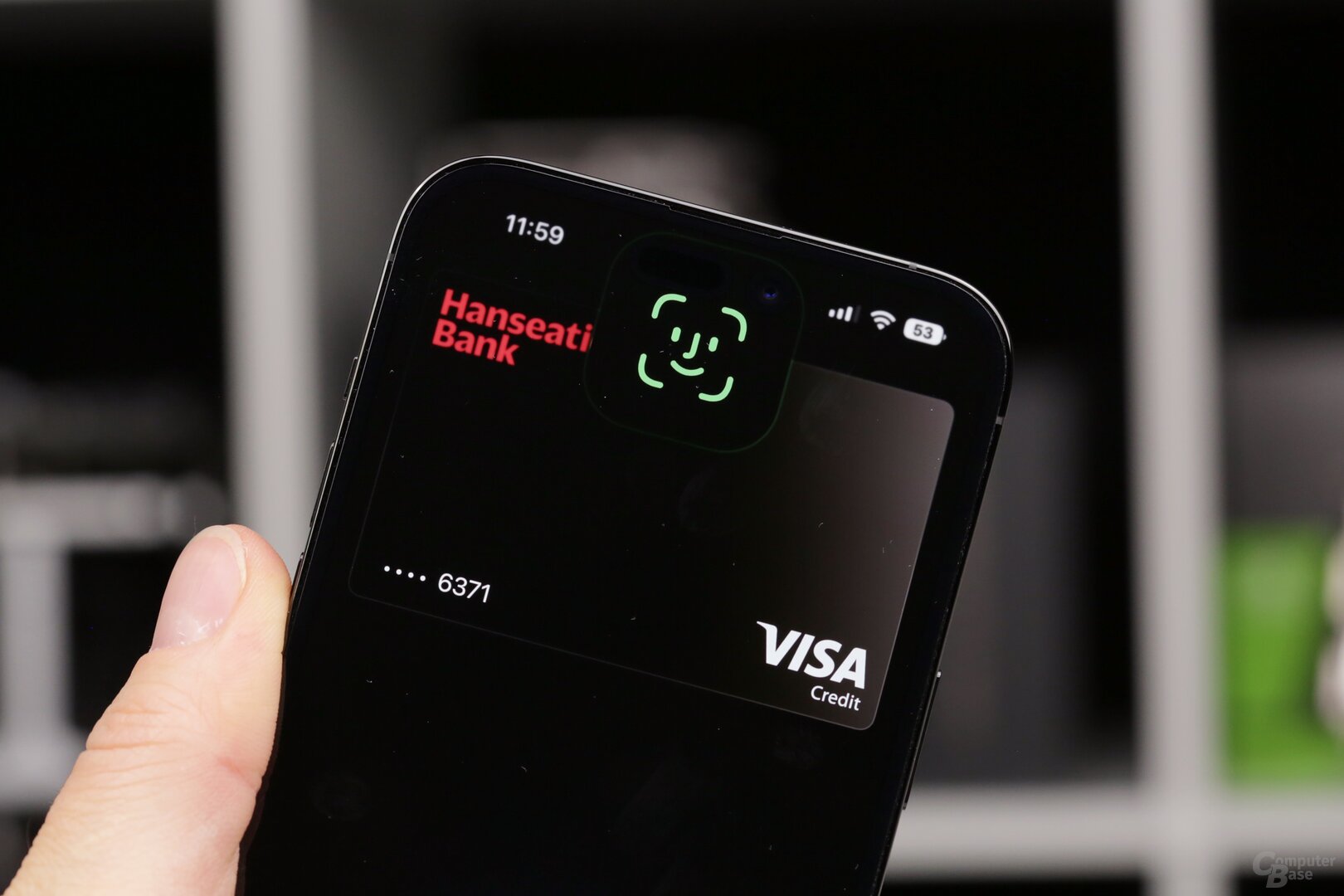 Animation for Face ID in Dynamic Island
Animation for Face ID in Dynamic Island
However, the Dynamic Island not only shows what is currently running in the background, but also invites you to interact with this content. Holding the respective hint for a long time opens a pop-up at the top of the screen to perform basic functions of the app, while a single tap leads to the app's full-screen view. This in turn creates a whole new multitasking area on iPhone, complementing the previous one accessed by swiping and holding from the bottom of the screen. This type of implementation can be called clever or confusing, with power users more likely to welcome the new option to switch between tasks, while everyone else can continue to use the previous variant.
The best OLED display for a smartphone
The island still has its “ocean” at 6.1 inches (Pro) and 6.7 inches (Pro Max), although Apple has marginally reduced the screen edges, so that the iPhone 14 Pro Max now has 6 pixels in width and 8 pixels in height have been added. More interesting than the number of pixels, however, is what has changed on the technical side of the OLED panel, which Samsung continues to contribute and has to meet Apple's highest requirements, which is why other suppliers have such a hard time.
The brightness of the OLED screen has been increased significantly. While last year Apple specified a maximum typical luminance of 1,000 cd/m² and a peak brightness of 1,200 cd/m² for HDR for the iPhone 13 Pro (Max), it is now 1,000 cd/m² and 1,600 cd/m² in the scenarios mentioned. m². In addition, there is a new specification of 2,000 cd/m² especially for the peak brightness outdoors. But what exactly is behind this specification and how exactly can it be achieved in everyday life?
APL now also decisive for brightness at Apple
With the iPhone 14 Pro Max, there are four factors that affect brightness: manually or automatically regulated brightness, and SDR and HDR playback. Last year, Apple introduced for the first time that the peak values of the panel can only be called up in automatic mode, but there was still no APL regulation via the “Average Picture Level”, i.e. the amount of white on the panel, as other manufacturers do in Android segment have been doing for years. This procedure is history with the iPhone 14 Pro (Max), so that the APL now also plays a role here for the very highest values - but not always, as the measurements show.
 6.7-inch OLED display has a brightness of over 2,300 cd/m²
6.7-inch OLED display has a brightness of over 2,300 cd/m²Same brightness with manual control
The screen goes through the beginning of the measurements in the manually controlled mode by selecting the “Display & Text Size” auto-brightness has been disabled. The “True Tone” and “Night Shift” features were also switched off for the measurements. With a determined 847 cd/m² in manual mode, the iPhone 14 Pro Max is no brighter than an iPhone 13 Pro or iPhone 13 Pro Max, which also came to around 850 cd/m² with the same settings. It is therefore clear that the iPhone 14 Pro can only develop its full potential when using auto-brightness.
Over 2,300 cd/m² is a new record
The automatic mode is linked to the APL this year, so that the peak brightness can be higher in certain areas if only a small pixel area is active. First off, the iPhone 14 Pro Max is just as bright as last year's iPhone 13 Pro Max at 1049 nits at 100 percent APL. The peak brightness of up to 2,000 cd/m² advertised by Apple can only be achieved when the APL is reduced. However, while other manufacturers only release the maximum for very small areas, the iPhone 14 Pro Max was already able to determine an extremely high 2,040 cd/m² with an APL of 20 percent. Apple is even selling below value, because with only 10 percent APL, even 2,306 cd/m² were possible.
For comparison: The Galaxy S22 Ultra (test) achieved a slightly better 1,161 cd/m² at 100 percent APL, but “only” 1,756 cd/m² and 1,864 cd/m² in the two levels above. With an identical APL, the OLED panel in the Apple smartphone is just 16 percent or 24 percent brighter. The screen in the Galaxy S22 Ultra was already extremely bright, but Apple has taken it to an even higher level in the iPhone 14 Pro Max, which allows for perfect reading when used outdoors, even in the brightest ambient light. Apple states a peak brightness of 1,600 cd/m² for HDR video, but in the test up to 2,290 cd/m² were also possible here at 10 percent APL.
Charts
- Display brightness max.
- Display brightness min.< /li>
- Display contrast
87 entries Display brightness max.
- Automatic mode 100% APL:
- Apple iPhone 14 Pro Max (Auto, 10% APL)2,306White point: approx. 6,300 li>
- Apple iPhone 14 Pro Max (Auto, 20% APL)2,040White point: approx. 6,300
- Samsung Galaxy S22 +1,182White point: approx. 6,700
- Samsung Galaxy S22 Ultra1,161White point: approx. 6,700
- Apple iPhone 13 Pro1,063White point: approx. 6,800
- Apple iPhone 13 Pro Max1,056White point: approx. 6,300
- Apple iPhone 14 Pro Max (Auto, 100% APL) 1,049White point: approx. 6,300
- Samsung Galaxy Z Fold 41,004White point: approx. 6,700
- Samsung Galaxy S21 Ultra973White point: approx. 6,700
- Samsung Galaxy Note 20 Ultra969White point: approx. 7,300
- Samsung Galaxy S22911White point: approx. 6,800
- Samsung Galaxy Z Flip 3894White point: approx. 6,600
- Xiaomi Mi 11 Ultra878 white point: approx. 7,100
- Samsung Galaxy Z Flip 4873 white point: approx. 6,600
- Apple iPhone 13 mini858White point: approx. 6,200
- Apple iPhone 12 Pro Max854White point: approx. 6,300
- Apple iPhone 14 Pro Max ( Manual, 100% APL)847White point: approx. 6,300
- Apple iPhone 12 Pro842White point: approx. 6,300
- Google Pixel 6a816white point: approx. 6,500
- Apple iPhone 11 Pro Max797white point: approx. 6,900< /li>
- OnePlus 9 Pro787 white point: approx. 6,800
- Asus ROG Phone 6784White point: approx. 7,200
- Xiaomi Mi 11783White point: approx. 6,900
- Google Pixel 6 Pro777 white point: approx. 6,500
- OnePlus 9776 white point: approx. 6,700
- OnePlus 8 Pro773 white point: approx. 7,400
- Samsung Galaxy A52 5G772 white point: approx. 6,800
- Google Pixel 6769 white point: approx. 6,200
- Qualcomm Smartphone for Snapdragon Insiders765 white point: approx. 7,200< /li>
- Samsung Galaxy S20763 White Point: Approx. 7,200
- Samsung Galaxy S20 Ultra762 white point: approx. 7,200
- Asus Zenfone 9757 white point: approx. 7,100
- OnePlus 8T753 white point: approx. 6,800
- Samsung Galaxy S20+752 white point: approx. 7,300
- Oppo Find X3 Pro745 white point: approx. 7,200
- Unihertz Titan718 white point: approx. 6,900
- Google Pixel 4a701White point: approx. 7,000
- LG Wing688White point: approx. 7,200
- Apple iPhone Xr686White point: approx. 7,000
- Cat S61672White point: approx. 7,400
- Samsung Galaxy Z Fold 2672White point: approx. 7,400
- Gigaset GX290671 white point: approx. 9,800
- Apple iPhone 11661 white point: approx. 6,800
- Google Pixel 4a 5G655white point: approx. 6,600
- Apple iPhone 12653white point: approx. 6,300
- Apple iPhone Xs Max644 white point: approx. 6,900
- Apple iPhone 12 mini643White point: approx. 6,300
- Nothing Phone (1)643White point: approx. 6,100
- Samsung Galaxy Note 9637white point: approx. 7,800
- Motorola Moto G8 Plus634white point: approx. 7,700
- OnePlus Nord629 white point: approx. 7,400
- Samsung Galaxy S9+624 white point: approx. 7,800
- Samsung Galaxy S9622White point: about 7,700
- Huawei Mate 20 Pro616White point: about 7,300
- Samsung Galaxy Note 10+616 white point: approx. 7,200
- OnePlus Nord 2610 white point: approx. 7,100
- OnePlus 6607 white point: approx. 7,900
- Motorola Moto G6589White point: approx. 8,800
- OnePlus 7 Pro585 white point: approx. 7,300
- LG Velvet575 white point: approx. 7,800
- Samsung Galaxy XCover6 Pro575 white point: approx. 7,500
- Sony Xperia XZ3569 White Point: Approx. 7,900
- Sony Xperia 5 III563White point: approx. 7,200
- Samsung Galaxy S10e562White point: approx. 7,400
- Cat S52553 White Point: approx. 6,900
- LG G7 ThinQ546White Point: approx. 9,300
- Cat S62 Pro543White Point: approx. 8,650
- Sony Xperia 1 II539 White point: approx. 8,400
- Sony Xperia 5 II536White point: approx. 7,500
- Huawei P30 Pro531White point: approx. 7,800
- Huawei P20 Pro527 white point: approx. 6,900
- Asus ZenFone 6525 white point: approx. 7,400
- Samsung Galaxy S10+524 white point: approx. 7,200
- Oppo Reno2521 white point: approx. 8,000
- Samsung Galaxy S10519White point: approx. 7,200
- Motorola Moto G7 Plus518White point: approx. 8,200
- Huawei P40 Pro516 white point: approx. 7,500
- Samsung Galaxy A50515 white point: approx. 7,100
- Motorola One Vision510 white point: approx. 8,000
- Cat S42510 white point: approx. 6,900
- Oppo A91508 white point: approx. 7,600
- Doogee V20508 white point: approx. 8,690
- Sony Xperia XZ2 Compact506 white point: approx. 7,900
- Motorola Moto G7 Power506white point: approx. 6,900
- Vivo X60 Pro503white point: approx. 7,600
- Gigaset GS4501 white point: approx. 9,700
- Oppo Find X2 Pro482White point: approx. 7,900
- Nokia 7 Plus473White point: approx. 7,800
- Motorola Moto G7473White Point: approx. 7,900
- Xiaomi Mi Mix 2S472White Point: approx 7,800
- Motorola One470 white point: about 7,700
- Samsung Galaxy A6463 white point: approx. 8,100
- Gigaset GS5456 white point: approx. 8,385
- LG G8s455 white point: approx. 7,800
- Motorola Moto Z3 Play444 white point: approx. 7,500
- OnePlus 6T431 white point: approx. 8,100
- Google Pixel 4 XL428White point: approx. 6,900
- BlackBerry Key2420White point: approx. 7,800
- Google Pixel 3a406 white point: approx. 6,900
- Google Pixel 3 XL400 white point: approx. 7,200
- HTC U12+399 white point: approx. 7,500
- Sony Xperia 1381 white point: approx. 7,600
li>
li>
li>
Unit: Luminance (cd/m²) 86 entries Display brightness min
-
- Xiaomi Mi Mix 2S1
- OnePlus 62
- Nokia 6.12
- Samsung Galaxy Note 92
- Sony Xperia XZ32
- Apple iPhone Xs Max2
- Google Pixel 3 XL2
- OnePlus 6T2
- Apple iPhone Xr2
- Motorola Moto G7 Plus2
- Samsung Galaxy S10+2
- Samsung Galaxy S102
- Samsung Galaxy S10e2
- Huawei P30 Pro2
- Google Pixel 3a2
- OnePlus 7 Pro2
- Samsung Galaxy A502
- Samsung Galaxy Note 10+2
- OnePlus 7T2
- Apple iPhone 112
- Apple iPhone 11 Pro Max2
- Google Pixel 4 XL2
- Samsung Galaxy S202
- Samsung Galaxy S20 +2
- Samsung Galaxy S20 Ultra2
- Oppo Find X2 Pro2
- Huawei P40 Pro2
- Oppo A912
- LG Velvet2
- Sony Xperia 1 II2
- Google Pixel 4a2
- Samsung Galaxy Note 20 Ultra2
- Samsung Galaxy Z Fold 22
- Google Pixel 52
- Sony Xperia 5 II2
- Google Pixel 4a 5G2
- Apple iPhone 122
- Apple iPhone 12 Pro2
- Apple iPhone 12 Pro Max2
- Apple iPhone 12 mini2
- Samsung Galaxy S21 Ultra2
- Xiaomi Mi 112
- OnePlus 9 Pro2
- Samsung Galaxy A52 5G2
- Xiaomi Mi 11 Ultra2
- Vivo X60 Pro2
- OnePlus Nord 22
- Samsung Galaxy Z Flip 32
- Apple iPhone 13 Pro2
- Apple iPhone 13 mini2
- Apple iPhone 13 Pro Max2
- Google Pixel 62
- Google Pixel 6 Pro2
- Samsung Galaxy S22+2
- Samsung Galaxy S22 Ultra2
- Samsung Galaxy S222
- Nothing Phone (1)2
- Google Pixel 6a2
- Asus Zenfone 92
- Samsung Galaxy Z Fold 42
- Samsung Galaxy Z Flip 42
- Apple iPhone 14 Pro Max (Auto, 100% APL)2
- HTC U12+3
- Motorola Moto G7 Power3
- Motorola Moto G73
- Motorola One Vision3
- Sony Xperia 13
- LG G8s3
- OnePlus 8 Pro3< /li>
- OnePlus 8T3
- LG Wing3
- OnePlus 93
- Oppo Find X3 Pro3
- Nokia XR203
- Samsung Galaxy A64< /li>
- BlackBerry Key24
- Huawei Mate 20 Pro4
- Asus ZenFone 64
- Gigaset GX2904
- OnePlus Nord4
- Sony Xperia 5 III4
- Sony Xperia XZ2 Compact5
- LG G7 ThinQ5
- Motorola Moto G8 Plus5
- Gigaset GS45
- Qualcomm Smartphone for Snapdragon Insiders5
- Asus ROG Phone 65
- Samsung Galaxy S96
- Samsung Galaxy S9+6
- Motorola Moto G66
- Nokia 7 Plus6
- Motorola One6< /li>
- Samsung Galaxy XCover6 Pro6
- Motorola Moto Z3 Play7
- Cat S4210
- Unihertz Titan11
- Cat S62 Pro11
- Huawei P20 Pro15
- Gigaset GS518
- Cat S5221
- Cat S6127
- Doogee V2030
Unit: Luminance (cd/m²) 87 entries Display contrast
-
- Samsung Galaxy S95,000:1OLED display
- Samsung Galaxy S9+5,000:1OLED display
- Huawei P20 Pro5,000:1OLED display
- OnePlus 65,000:1OLED display
- Samsung Galaxy A65.000:1OLED display
- Motorola Moto Z3 Play5 .000:1OLED display
- Samsung Galaxy Note 95.000:1OLED display
- Sony Xperia XZ35.000:1OLED display
- Apple iPhone Xs Max5,000:1OLED display
- Google Pixel 3 XL5,000:1OLED display
- Huawei Mate 20 Pro5,000:1OLED display
- OnePlus 6T5,000:1OLED display
- Samsung Galaxy S10+5,000:1OLED display
- Samsung Galaxy S105.000:1OLED display
- Samsung Galaxy S10e5000:1OLED Display
- Huawei P30 Pro5000:1OLED Display
- Google Pixel 3a5,000:1OLED display
- OnePlus 7 Pro5,000:1OLED Display
- Samsung Galaxy A505,000:1OLED Display
< li class="chart__row chart__row--hidden toggle-body-item nojs-tr">Sony Xperia 15,000:1OLED display
- LG G8s5,000:1OLED display
- Samsung Galaxy Note 10+5,000:1OLED display
- OnePlus 7T5,000:1OLED display
- Apple iPhone 11 Pro Max5,000:1OLED display
- Google Pixel 4 XL5,000:1OLED display
- Oppo Reno25.000:1OLED display
- Samsung Galaxy S205.000:1OLED display
- Samsung Galaxy S20+5,000:1OLED display
- Samsung Galaxy S20 Ultra5000:1OLED Display
- Oppo Find X2 Pro5000:1OLED Display
- Huawei P40 Pro5,000:1OLED display
- OnePlus 8 Pro5,000:1OLED display
- Oppo A915,000:1OLED display
- LG Velvet5.000:1OLED display
- Sony Xperia 1 II5,000:1OLED display
- OnePlus Nord5,000:1OLED display
- Google Pixel 4a5,000:1OLED display
- Samsung Galaxy Note 20 Ultra5,000:1OLED display
- Samsung Galaxy Z Fold 25,000:1OLED display
- Google Pixel 55,000:1OLED display
- OnePlus 8T5,000:1OLED display
- Sony Xperia 5 II5,000:1OLED display
- Google Pixel 4a 5G5,000:1OLED Display
- Apple iPhone 125,000:1OLED Display
- Apple iPhone 12 Pro5,000:1OLED display
- Apple iPhone 12 Pro Max5000:1OLED Display
- Apple iPhone 12 mini5000:1OLED Display< /li>
- LG Wing5.000:1OLED display
- Samsung Galaxy S21 Ultra5,000:1OLED Display
- Xiaomi Mi 115,000:1OLED Display
- OnePlus 95,000:1OLED display
- OnePlus 9 Pro5,000 :1OLED display
- Oppo Find X3 Pro5.000:1OLED display
- Samsung Galaxy A52 5G5,000:1OLED display
- Xiaomi Mi 11 Ultra5,000:1OLED display
- Vivo X60 Pro5,000:1OLED Display
- OnePlus Nord 25,000:1OLED Display
- Qualcomm Smartphone for Snapdragon Insiders5,000:1OLED display
- Samsung Galaxy Z Flip 35,000:1OLED display
- Sony Xperia 5 III5,000:1OLED display
- Apple iPhone 13 Pro5,000:1OLED display
- Apple iPhone 13 mini5,000:1OLED display
- Apple iPhone 13 Pro Max5,000:1OLED display
- Google Pixel 65,000:1OLED display< /li>
- Google Pixel 6 Pro5,000:1OLED display
- Doogee V205,000:1OLED display
- Samsung Galaxy S22+5,000:1OLED display< /li>
- Samsung Galaxy S22 Ultra5,000:1OLED display
- Samsung Galaxy S225,000:1OLED display
- Asus ROG Phone 65,000:1OLED display
- Nothing Phone (1)5,000:1OLED display
- Google Pixel 6a5,000:1OLED display
- Asus Zenfone 95,000:1OLED display
- Samsung Galaxy Z Fold 45,000:1 OLED display
- Samsung Galaxy Z Flip 45,000:1 OLED display
- Apple iPhone 14 Pro Max (Auto , 100% APL)5,000:1OLED display
- Xiaomi Mi Mix 2S2.471:1
- HTC U12+2.241:1
- Nokia 7 Plus2.130:1
- Motorola One1.980:1
- BlackBerry Key21.875:1
- Motorola Moto G7 Power1.833:1
- Cat S521.728:1
- Apple iPhone Xr1.670:1
- Motorola Moto G8 Plus1.665: 1
- Apple iPhone 111.597:1
- Asus ZenFone 61.551:1
- Nokia XR201.518:1
- Motorola Moto G71.511:1
- Cat S62 Pro1.429:1
- Gigaset GS41.407:1
- Cat S611.400:1
- Cat S421.378:1
- Gigaset GX2901.367:1
- Samsung Galaxy XCover6 Pro1.275:1
- Motorola Moto G7 Plus1.230:1
- Nokia 6.11.180:1
- Gigaset GS51.151:1
- Motorola Moto G61.081:1
- Sony Xperia XZ2 Compact1.068:1
- Motorola One Vision1.045:1
- Unihertz Titan953:1
li>
li>
li>
Unit: Contrast
Always-on-Display works with 1 Hz
The Pro variants of the iPhone 14 are still the only two that support adaptive refresh rates up to 120 Hz and can go down to a minimum of 10 Hz in regular iOS operation to save energy. With the latest generation LTPO OLED panel supplied by Samsung, which appears to be a generation ahead of what Samsung is putting in its own smartphones, comes a mode down to just 1 Hz that Apple has brought to the always-on screen reserved, which can also be used exclusively on the iPhone 14 Pro and iPhone 14 Pro Max.
So “on” is no other always-on -Display
After years of speculation, Apple now also has an always-on display – of course not just any old one, but one developed in its very own way. With Apple, the entire lock screen of the smartphone is permanently dimmed, but still shows colors and all widgets and other lock screen customizations. The editors set up a completely white lock screen as a test and determined a brightness of 75 cd/m² – unusually bright for an always-on screen. Apple's implementation looks like the smartphone was accidentally left with the screen permanently activated at 5 percent brightness. The iPhone 14 Pro Max's always-on screen is literally “always on”.
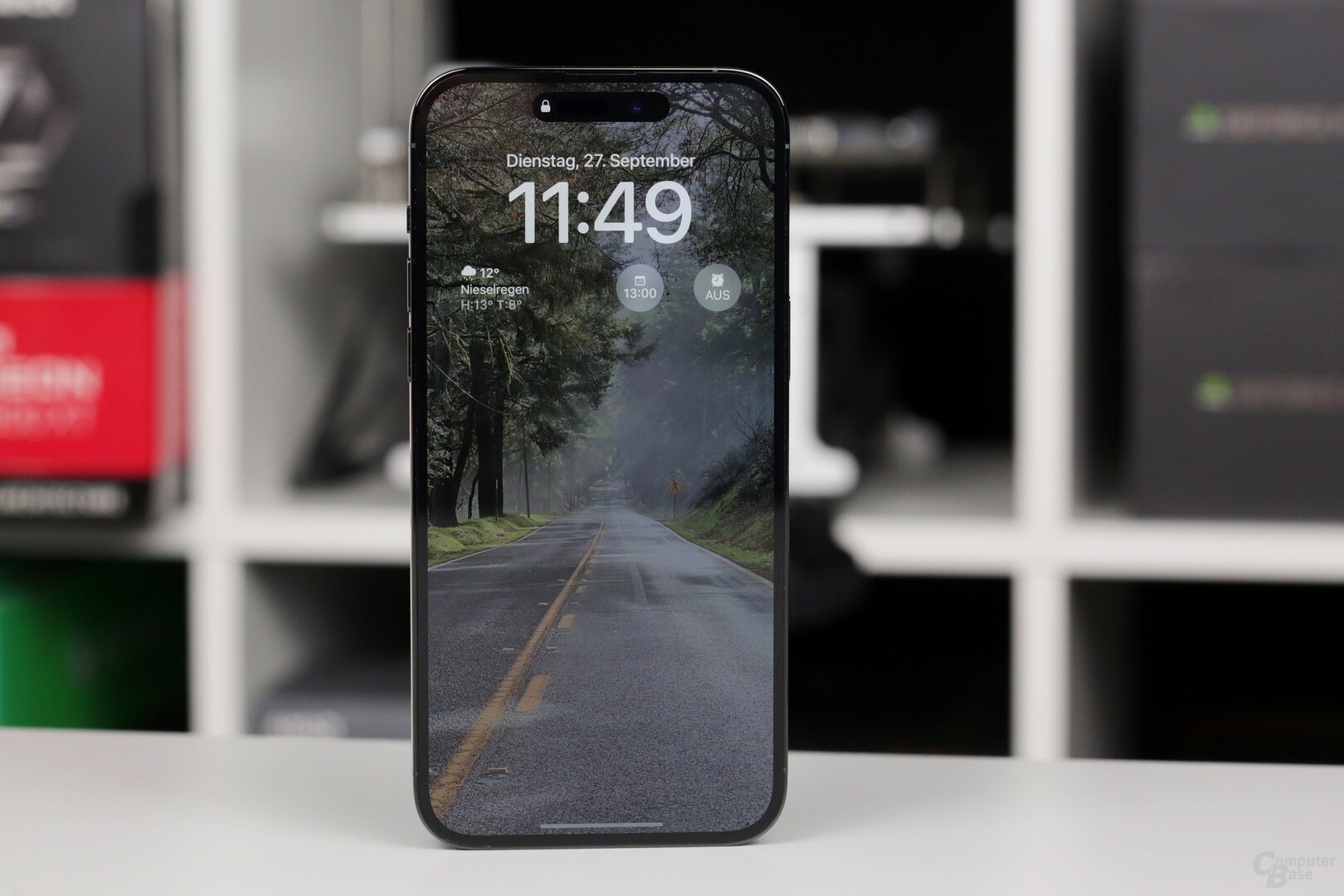 The always-on screen is extremely bright
The always-on screen is extremely bright Image 1 of 2
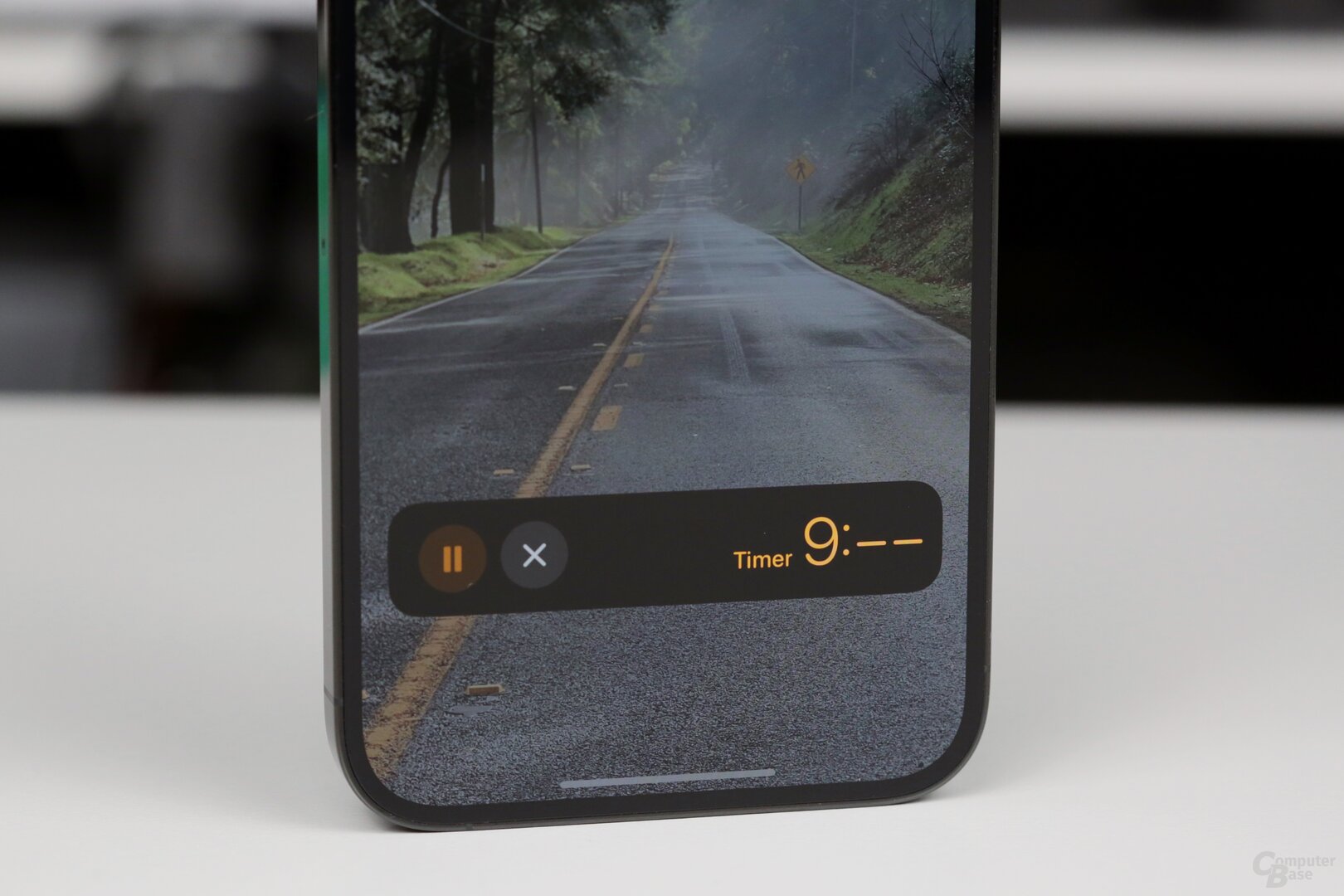 Always-on screen waives seconds on timer
Always-on screen waives seconds on timerIn order to save the battery, the manufacturer does without unnecessary animations on the always-on display. For example, if a timer is running on the device, it is only displayed with the remaining minutes. The user only sees the individual seconds ticking for the last minute. As soon as the smartphone is woken up, the seconds appear on the lock screen regardless of the remaining time. The influence of the always-on display on the battery life is difficult to judge. Spread over the day, however, an iPhone with an always-on display loses a few percentage points more when not in use than an iPhone without this feature. Incidentally, Apple's own information on battery life has all been determined without the always-on screen. The manufacturer says that the feature itself was active in the settings, but the display was not visible.
Audio playback is shorter when the Always-On Display is visible compared to the audio playback of an iPhone placed upside down on a table or in a bag or backpack.
Apple
Energy consumption reduced through savings
There are several options to minimize power consumption by using the always-on display. For example, the screen does not remain active as soon as the device is placed face down or placed in a pocket. The mode remains off even if the focus is set to “Sleep”, the energy saving mode has been activated, the smartphone is connected to CarPlay or the “Continuity Camera” function is used for use as a webcam. In addition, the device recognizes when it has not been used for a long time, such as when an alarm is set, and then deactivates the always-on screen. Apple Watch owners also benefit from the fact that the always-on display is only active when both devices are nearby.
Hidden black and white mode
If the user is in a focus mode, the always-on screen can also be further reduced by activating “Dim lock screen” in the options. The iPhone then only shows the time, date and widgets on a black background without the wallpaper. However, this level makes little sense for everyday use, because a focus mode has to be used permanently and the lock screen is displayed without a wallpaper even after the display is activated. If you don't want to use the always-on screen, which is activated by default, you can switch it off under “Display & Brightness” by deselecting the “Always on” option.
For increased efficiency, however, Apple is also said to be using the new A16 Bionic from 4 nm production by TSMC In terms of performance, it again delivers a little more than last year's model, as the following page of the test shows.
Page 1/4 Next page
A16 Bionic benchmark and battery life